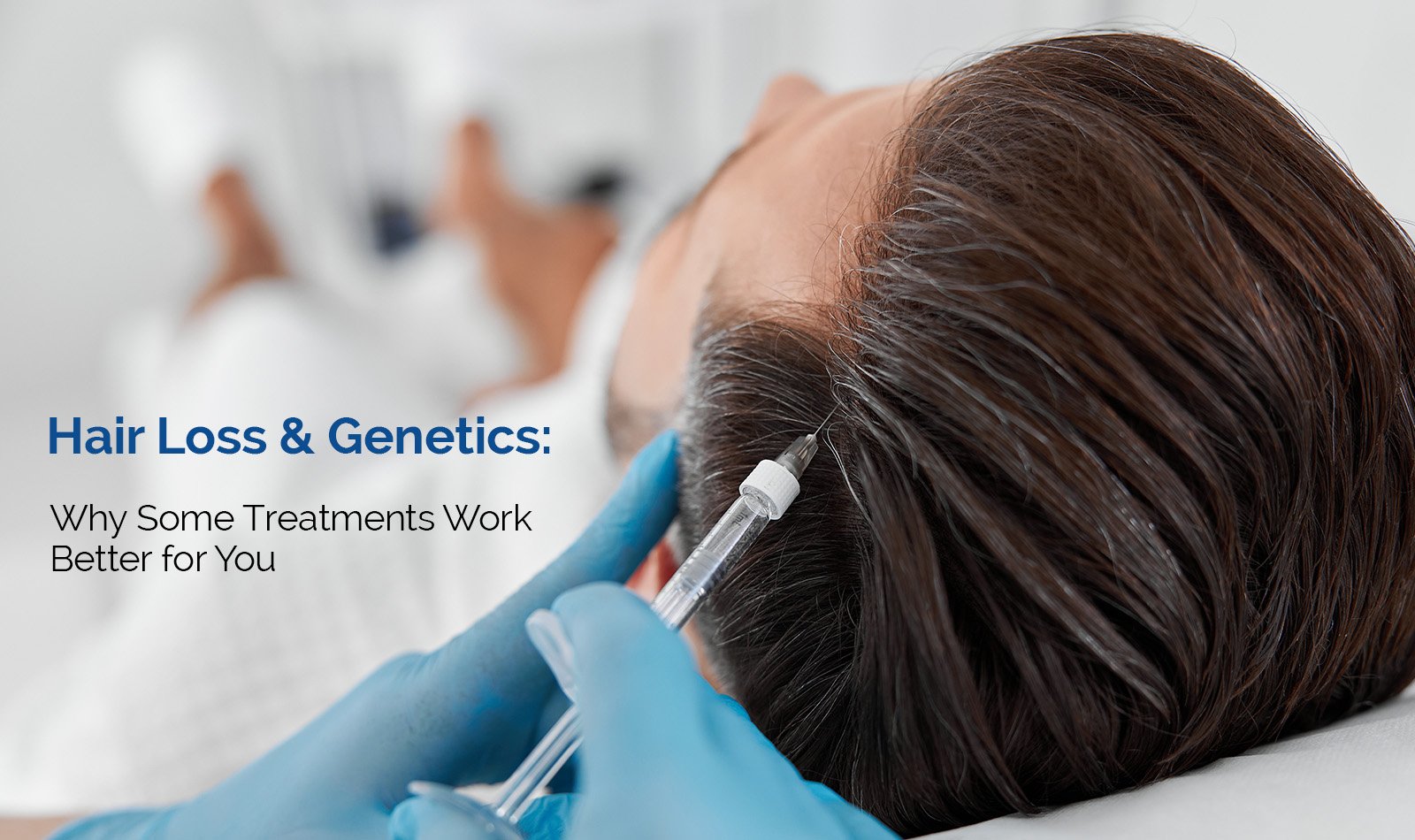Contents
You look at yourself staring at the mirror, noticing your hair’s not as thick as it used to be. Maybe your dad has the same receding look, or your mom’s side handed down the thinning gene. It feels unfair that the underlying cause often lies within genetics. This explains why certain hair loss treatments are effective for some individuals yet fail for others. Hair loss treatment is never one-size-fits-all. Your DNA shapes how your scalp responds.
Recognizing this genetic influence is a crucial first step in selecting an appropriate and potentially effective approach to managing hair loss.
What Genetic Hair Loss Means
Genetic hair loss, also known as androgenetic alopecia, is the most common cause of thinning hair worldwide. It happens when follicles are sensitive to dihydrotestosterone (DHT). Over time, they shrink, and the hair they produce becomes finer until it stops growing.
In men, this condition typically manifests as a receding hairline or thinning at the crown. Women, on the other hand, are more likely to observe a widening of the part line or diffuse thinning distributed across the scalp. Statistically, by the age of fifty, over half of all men and nearly forty percent of women experience some degree of androgenetic alopecia. Unlike hair loss triggered by acute stress or external factors, genetic hair loss persists without
intervention and does not resolve spontaneously.
Why Treatment Response Differs
Two people can start the same treatment and see very different results. Genetics influence how sensitive follicles are to hormones, how quickly thinning progresses, and how well the scalp heals. That is why some respond to medications like minoxidil or finasteride, while others need regenerative or surgical options.
Timing matters too. Early intervention protects active follicles, while late treatment works on fewer remaining ones. A person who starts therapy at the first signs of thinning has a stronger chance of maintaining density compared to someone who waits years.
PRP vs Exosomes: How They Compare
Platelet Rich Plasma (PRP) has been used for over a decade. Blood is drawn, spun, and growth factors are injected into the scalp. It works best in early stages of thinning, when follicles are still active.
Exosome therapy for hair loss is newer. Exosomes are microscopic vesicles derived from stem cells. They carry signals that repair and regenerate tissue. Studies in 2024 showed exosomes produced stronger regrowth than PRP for moderate to advanced cases. Unlike PRP, they are not dependent on the quality of your own blood, which makes outcomes more consistent.
| Treatment | Source | Action | Best Stage | Limitations |
| PRP | Patient’s blood | Stimulates follicles with growth factors | Early thinning | Variable results requires multiple sessions |
| Exosomes | Stem cell vesicles | Regenerates and repairs follicle cells | Moderate to advanced thinning | Higher cost, newer therapy |
- Both treatments are considered safe, but selecting one really depends on the extent of your genetic hair loss. In some cases, a combined approach works well: PRP can stimulate the scalp, while exosomes offer more substantial repair. This method leverages the strengths of both therapies for optimal scalp health.
Hair Restoration Beyond Regeneration
For advanced thinning, where large areas are bald, hair restoration surgery remains the most reliable solution. Follicular Unit Extraction (FUE) and Direct Hair Implantation (DHI) are the most common methods today. Results improve when surgery is paired with regenerative therapies like PRP or exosomes, which strengthen transplanted follicles and surrounding hair.
Modern restoration is not about quick fixes. It is about creating a sustainable plan where medical, regenerative, and surgical treatments work together
The Importance of a Hair Loss Consultation
If you’ve been experiencing persistent hair thinning, a consultation isn’t something you want to skip. Self-directed treatments frequently lead to wasted time and resources without targeting the actual problem. A specialist will conduct a thorough scalp examination, review your medical background, and identify possible underlying factors like thyroid dysfunction or low iron levels. From there, they’ll develop a treatment strategy that aligns with your unique genetic and physiological profile.
This is typically the stage where patients begin to see meaningful improvement. Rather than constantly cycling through over-the-counter products, you gain a clear understanding of how your hair responds to specific interventions, allowing for a more targeted and effective approach.
Dr Fehmida’s Approach to Genetic Hair Loss
Dr Fehmida combines science with individualized care. She provides PRP and exosome therapy, tailoring treatment to the stage of thinning. For advanced genetic hair loss, she recommends modern transplant options, often paired with regenerative support for long-term results. Her method is practical. She focuses on evidence, tracks progress, and adjusts treatment based on real results, not guesswork.
Final Take:
Genetic hair loss is not random. It follows patterns that science understands well today. Understanding the specific behavior of your hair follicles can spare you unnecessary trial and error. Whether you initiate treatment with PRP, progress to exosome therapy, or opt for restoration procedures, the central principle remains: early intervention under the guidance of a qualified professional is essential for optimal outcomes.

